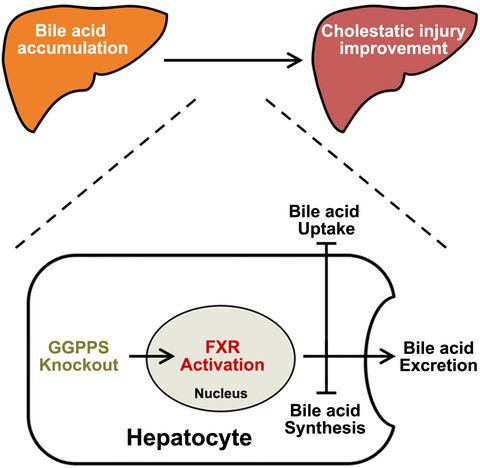Our official English website, www.x-mol.net, welcomes your feedback! (Note: you will need to create a separate account there.)
Conditional loss of geranylgeranyl diphosphate synthase alleviates acute obstructive cholestatic liver injury by regulating hepatic bile acid metabolism.
The FEBS Journal ( IF 5.4 ) Pub Date : 2020-01-06 , DOI: 10.1111/febs.15204 Wen-Jun Jia 1, 2, 3 , Qiao-Li Tang 2 , Shan Jiang 2 , Shi-Quan Sun 3 , Bin Xue 4, 5 , Yu-Dong Qiu 3 , Chao-Jun Li 2 , Liang Mao 3
The FEBS Journal ( IF 5.4 ) Pub Date : 2020-01-06 , DOI: 10.1111/febs.15204 Wen-Jun Jia 1, 2, 3 , Qiao-Li Tang 2 , Shan Jiang 2 , Shi-Quan Sun 3 , Bin Xue 4, 5 , Yu-Dong Qiu 3 , Chao-Jun Li 2 , Liang Mao 3
Affiliation

|
Previous studies have suggested that metabolites in the mevalonate pathway are involved in hepatic bile acid metabolism, yet the details of this relationship remain unknown. In this study, we found that the hepatic farnesyl pyrophosphate (FPP) level and the ratio of FPP to geranylgeranyl pyrophosphate (GGPP) were increased in mice with acute obstructive cholestasis compared with mice that underwent a sham operation. In addition, the livers of the mice with acute obstructive cholestasis showed lower expression of geranylgeranyl diphosphate synthase (GGPPS), which synthesizes GGPP from FPP. When Ggps1 was conditionally deleted in the liver, amelioration of liver injury, as shown by downregulation of the hepatic inflammatory response and decreased hepatocellular apoptosis, was found after ligation of the common bile duct and cholecystectomy (BDLC). Subsequently, liquid chromatography/mass spectrometry analysis showed that knocking out Ggps1 decreased the levels of hepatic bile acids, including hydrophobic bile acids. Mechanistically, the disruption of Ggps1 increased the levels of hepatic FPP and its metabolite farnesol, thereby resulting in farnesoid X receptor (FXR) activation, which modulated hepatic bile acid metabolism and reduced hepatic bile acids. It was consistently indicated that digeranyl bisphosphonate, a specific inhibitor of GGPPS, and GW4064, an agonist of FXR, could also alleviate acute obstructive cholestatic liver injury in vivo . In general, GGPPS is critical for modulating acute obstructive cholestatic liver injury, and the inhibition of GGPPS ameliorates acute obstructive cholestatic liver injury by decreasing hepatic bile acids, which is possibly achieved through the activation of FXR‐induced bile acid metabolism.
中文翻译:

通过调节肝胆汁酸代谢,有条件地损失香叶基香叶基二磷酸香叶基合磷酸酯可减轻急性阻塞性胆汁淤积性肝损伤。
先前的研究表明,甲羟戊酸途径中的代谢物与肝胆汁酸代谢有关,但是这种关系的细节仍然未知。在这项研究中,我们发现与进行假手术的小鼠相比,患有急性阻塞性胆汁淤积的小鼠的肝法呢基焦磷酸(FPP)水平和FPP与香叶基香叶基焦磷酸焦磷酸(GGPP)的比例增加。此外,患有急性阻塞性胆汁淤积症的小鼠的肝脏显示出较低的香叶基香叶基香叶基二磷酸合酶(GGPPS)的表达,该酶由FPP合成GGPP。当Ggps1胆总管结扎术和胆囊切除术(BDLC)结扎后,发现肝脏中有条件地清除了肝炎后,肝脏中的肝素被清除,肝脏炎症反应的下调和肝细胞凋亡的减少表明肝脏损伤得到了改善。随后,液相色谱/质谱分析表明,敲除Ggps1会降低肝胆汁酸(包括疏水性胆汁酸)的水平。从机制上讲,Ggps1的破坏增加了肝FPP及其代谢产物法呢醇的水平,从而导致了法呢类X受体(FXR)的活化,从而调节了肝胆汁酸的代谢并减少了肝胆汁酸。一致表明,GGPPS的特异性抑制剂双香叶基双膦酸酯和FXR激动剂GW4064也可以减轻体内急性阻塞性胆汁淤积性肝损伤。通常,GGPPS对于调节急性阻塞性胆汁淤积性肝损伤至关重要,对GGPPS的抑制通过减少肝胆酸来改善急性阻塞性胆汁淤积性肝损伤,这可能是通过激活FXR诱导的胆汁酸代谢来实现的。
更新日期:2020-01-06
中文翻译:

通过调节肝胆汁酸代谢,有条件地损失香叶基香叶基二磷酸香叶基合磷酸酯可减轻急性阻塞性胆汁淤积性肝损伤。
先前的研究表明,甲羟戊酸途径中的代谢物与肝胆汁酸代谢有关,但是这种关系的细节仍然未知。在这项研究中,我们发现与进行假手术的小鼠相比,患有急性阻塞性胆汁淤积的小鼠的肝法呢基焦磷酸(FPP)水平和FPP与香叶基香叶基焦磷酸焦磷酸(GGPP)的比例增加。此外,患有急性阻塞性胆汁淤积症的小鼠的肝脏显示出较低的香叶基香叶基香叶基二磷酸合酶(GGPPS)的表达,该酶由FPP合成GGPP。当Ggps1胆总管结扎术和胆囊切除术(BDLC)结扎后,发现肝脏中有条件地清除了肝炎后,肝脏中的肝素被清除,肝脏炎症反应的下调和肝细胞凋亡的减少表明肝脏损伤得到了改善。随后,液相色谱/质谱分析表明,敲除Ggps1会降低肝胆汁酸(包括疏水性胆汁酸)的水平。从机制上讲,Ggps1的破坏增加了肝FPP及其代谢产物法呢醇的水平,从而导致了法呢类X受体(FXR)的活化,从而调节了肝胆汁酸的代谢并减少了肝胆汁酸。一致表明,GGPPS的特异性抑制剂双香叶基双膦酸酯和FXR激动剂GW4064也可以减轻体内急性阻塞性胆汁淤积性肝损伤。通常,GGPPS对于调节急性阻塞性胆汁淤积性肝损伤至关重要,对GGPPS的抑制通过减少肝胆酸来改善急性阻塞性胆汁淤积性肝损伤,这可能是通过激活FXR诱导的胆汁酸代谢来实现的。



























 京公网安备 11010802027423号
京公网安备 11010802027423号